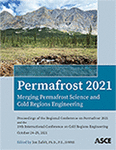Regional Conference on Permafrost 2021 and the 19th International Conference on Cold Regions Engineering
Synopsis: Permafrost Engineering in a Warming Climate—Current State and Future Strategy
Publication: Permafrost 2021: Merging Permafrost Science and Cold Regions Engineering
ABSTRACT
The permafrost engineering profession is challenged with the next stage of evolution, as the last few decades have seen a steady rise in permafrost temperature. The changing environment is generating uncertainty regarding safe engineering, and longevity, and the result is often overly conservative designs that greatly increase development costs. The ASCE Cold Regions Engineering Division (CRED) committees agreed a review of the current state of the profession and an outline of a future strategy were needed. The International Permafrost Association (IPA) sanctioned an action group to perform a workshop and look at the permafrost engineering discipline, determine knowledge gaps, and suggest a path forward. This paper presents a synopsis of the more important findings such as: the need for programmatic work in developing ‘living’ permafrost temperature forecast tools, technical advances in methods to design for increasing thaw sensitivity, designing and planning with threats from altered hydrology (thermo-erosion) and slope instabilities, and techniques to mitigate thaw-affected vertical and horizontal infrastructure, to name a few. Most importantly, the engineering profession, with the help of universities, must promote the backfill of the retiring frozen ground engineering workforce.
Get full access to this article
View all available purchase options and get full access to this chapter.
REFERENCES
Arcone, S. A., & Bjella, K. (2016). Ground-Penetrating-Radar Profiles of Interior Alaska Highways: Interpretation of Stratified Fill, Frost Depths, Water Table, and Thaw Settlement over Ice-Rich Permafrost. Cold Regions Research and Engineering Laboratory, US Army Engineer Research and Development Center Hanover.
Bjella, K.L., Shur, Y., Kanevskiy, M., Duvoy, P., Grunau, B., Best, J., Bourne, S. and Affleck, R.T., (2020). Improving design methodologies and assessment tools for building on permafrost in a warming climate.
Bjella, K., Arcone, S., & Douglas, T. (2015). Imaging of Ground Ice with Surface-Based Geophysics. Engineer Research and Development Center Hanover NH Cold Regions Research and Engineering Lab.
Bjella, K.L., (2014). Dalton Highway 9 to 11 Mile expedient resistivity permafrost investigation (No. FHWA-AK-RD-13-08). Alaska. Dept. of Transportation and Public Facilities. Research, Development and Technology Transfer.
Calmels, F., Roy L-P., Grandmont K., Pugh R. (2018). “ERT and Temperature Monitoring to Assess the Effectiveness of Insulating Culverts on Northern Highways. Whitehorse: Yukon Research Centre, Yukon College.
Cox, B., C. Wood, Kenan Hazirbaba (2012). Frozen and unfrozen shear wave velocity seismic site classification of Fairbanks, Alaska. J. of Cold Regions Engineering, 26(3).
de Grandpré, I., Fortier, D. and Stephani, E., 2012. Degradation of permafrost beneath a road embankment enhanced by heat advected in groundwater. Canadian Journal of Earth Sciences, 49(8), pp.953-962.
Holloway, J. E. and Lewkowicz, A. G. (2019). “Field and Laboratory Investigation of Electrical Resistivity-Temperature Relationships, Southern Northwest Territories.” Proc. 18th International Cold Regions Engineering and 8thCanadian Permafrost Conference, ASCE, Reston VA, 64-72.
Yang, Z., Utpal Dutta, Gang Xuet al., (2011). Numerical analysis of permafrost effects on the seismic site response. Soil Dynamics and Earthquake Engineering, 31, 282–290.
Yarmak, E. and Zottola, J. T. (2017). “Thermosyphon Design for a Changing Arctic.” Proc., Congress on Technical Advancement 2017: Cold Regions Engineering, ASCE, Reston, VA, 151-160.
Information & Authors
Information
Published In
Permafrost 2021: Merging Permafrost Science and Cold Regions Engineering
Pages: 233 - 244
Editor: Jon Zufelt, Ph.D., HDR Alaska
ISBN (Online): 978-0-7844-8358-9
Copyright
© 2021 American Society of Civil Engineers.
History
Published online: Oct 21, 2021
Published in print: Oct 21, 2021
Authors
Metrics & Citations
Metrics
Citations
Download citation
If you have the appropriate software installed, you can download article citation data to the citation manager of your choice. Simply select your manager software from the list below and click Download.
